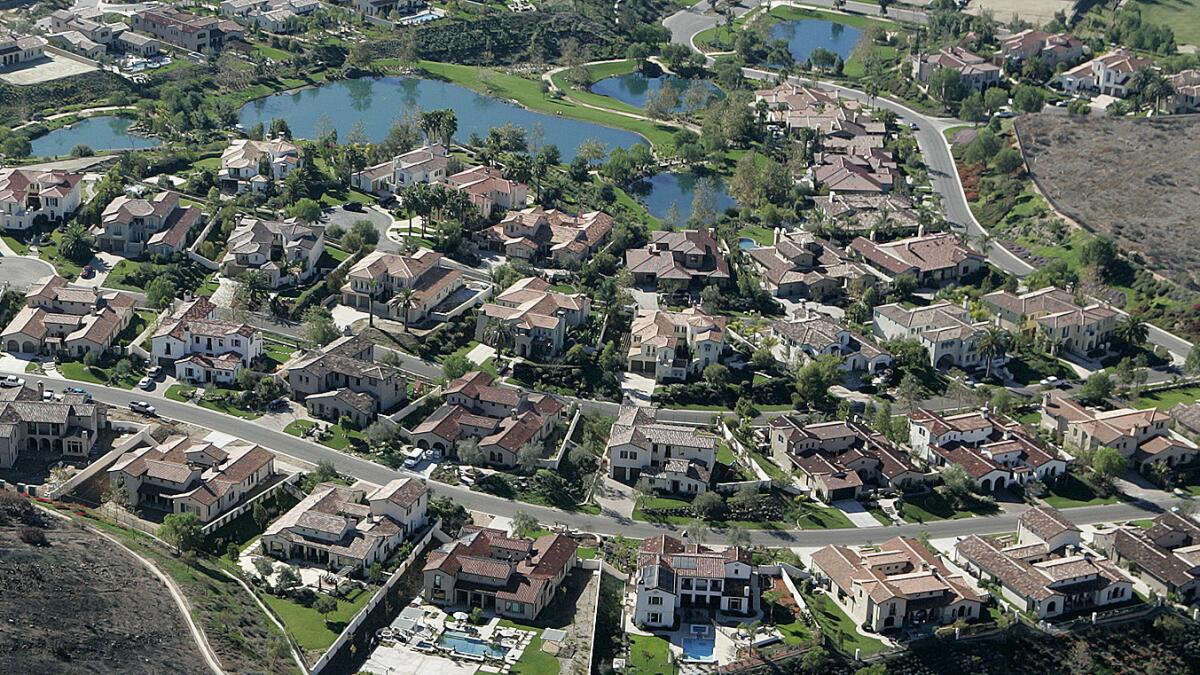Rancho Santa Fe water hog puts Bel-Air’s to shame

Rancho Santa Fe
- Share via
When it comes to single residences consuming large volumes of water, Bel-Air has nothing on Rancho Santa Fe.
An unnamed water user in Bel-Air made headlines last month for using 11.8 million gallons of water in a year, triggering widespread criticism of the “Wet Prince of Bel-Air.”
But it turns out that there’s a bigger water consumer farther south.
A household in the Rancho Santa Fe area in San Diego County used about 17% more water over the course of a year, reaching 13.8 million gallons by the end of September, according to a San Diego Union-Tribune survey of 23 local water retailers. That’s enough to supply more than 110 typical single-family homes or fill 21 Olympic-size swimming pools.
“I thought 11.8 million was shocking for a single-family home, but [this] is astounding,” said Tracy Quinn, a water policy analyst for the Natural Resources Defense Council in Santa Monica.
The prevalence of ranchettes and long-established hobby farms on residential properties in Rancho Santa Fe helps explain why residents use more water, Quinn said. But nearly 14 million gallons for a single home is hard to excuse during a water crisis.
The water district that serves Rancho Santa Fe has been held up nationally before as an example of copious water use. Customers of the Santa Fe Irrigation District, which also serves Fairbanks Ranch and Solana Beach, were using an average of 584 gallons per person per day — almost five times the average for coastal California — as of September 2014, according to a state report released last year.
In April, the state ordered the district to cut back 36% from its 2013 usage. As of September, it was exceeding its conservation target by almost 4%, and had reduced average residential use to 357 gallons per person per day, according to state data. The state average is 97 gallons per day.
In the newspaper’s survey of top water users in San Diego County for the 12 months that ended Sept. 30, six other single-family residential customers in the Santa Fe Irrigation District used more than 6 million gallons. The next closest jurisdiction was Poway, where one customer used 5.9 million gallons.
Santa Fe Irrigation District spokeswoman Jessica Parks said residential properties in Rancho Santa Fe are larger than many other jurisdictions and often include orchards and groves of citrus trees.
“People have large properties here that require more water, so just because we’re high users per capita doesn’t mean we’re wasteful,” Parks said.
When the Center for Investigative Reporting revealed the Bel-Air resident’s water use, the news prompted outrage. Lawmakers called for a crackdown on water hogs, and the city’s utilities department threatened to identify and possibly fine or cut water service to excessive water users.
See the most-read stories this hour >>
Utilities are not required by law to release information about individual customers, and they typically choose to withhold such information to protect the privacy of their customers.
But in the fourth year of a devastating drought, water agencies are under pressure to identify top residential water users, a public shaming that was a feature of previous California droughts.
Santa Fe Irrigation District’s water restrictions include limiting watering to two days a week. Fines start at $250 for the first violation, increasing to $1,000 for the fourth and each thereafter. Water rates also get steeper with higher use to encourage savings.
So far, some customers have triggered the special rates, but the district hasn’t slowed or shut off any customer’s water, Parks said.
morgan.cook@sduniontribune.com
Morgan Cook writes for the San Diego Union-Tribune.
ALSO:
Roofers flooded with calls ahead of El Niño
Santa Ana winds, rising temperatures bring heightened wildfire risk
‘Everything is blinding white’: Sierra storms pay off for resorts and add hope for drought
More to Read
Sign up for Essential California
The most important California stories and recommendations in your inbox every morning.
You may occasionally receive promotional content from the Los Angeles Times.













